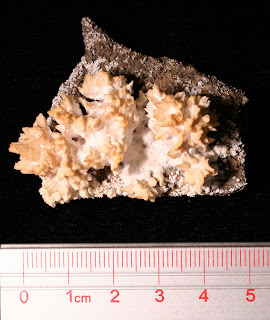Several weeks passed when I noticed something interesting in the container, formations of white crystals were forming. As it turns out a chemical reaction was taking place, one in which the limestone samples (calcium carbonate) were interacting with the vinegar (acetic acid) to form water, carbon dioxide, and calcium acetate (calcium salt). The carbon dioxide floated off into the atmosphere, the water eventually evaporated, which just left the limestone and crystallized calcium acetate.
Limestone + Vinegar = Calcium Salt + Water + Carbon Dioxide
CaCO3 + 2CH3COOH = Ca(CH3COO)2 + H2O + CO2
The calcium acetate formed a texture and color that reminded me of the layer of meringue that one finds on lemon pies.
 |
| Lemon Meringue Pie - photo by Renee Comet (1994) - wikipedia.org |








Great post. Chemistry and microfossils -- an unbeatable combination for fun.
ReplyDeleteThat is a very cool post, Mike. The reaction you are describing is the same one that they sell as "Popcorn Rock" in tourist shops. A chunk of limestone in a bag with instructions to leave it in vinegar for an extended period of time. Nice Conodont too!
ReplyDeleteThanks for the info. I wondered what "popcorn rocks" were.
ReplyDeleteThe chemical formation was a unintended bonus.
Sir is it possible for calcium acetate to form with vinegar and quartz combination
ReplyDeleteI do not believe so since quartz is SiO2 and vinegar (acetic acid) CH3COOH so there is no calcium element present to form the compound calcium acetate.
ReplyDelete